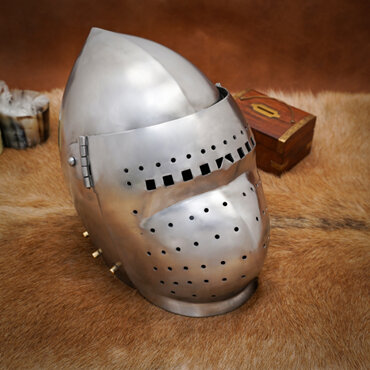
Most of the helmets are made from either 1.6mm or 2.0mm mild steel. 1.6mm is considered to be the minimum thickness for metal weapons combat and is still the standard for non-head blow or controlled head blow combat. It is also the minimum thickness that we use for jousting. We still think 1.6mm is safe for these applications but in recent years we have seen an increase in heavier style battle reenactment activities such as solid lance jousting and full head blow style combat. So more and more helmets are also being made from 2.0mm as well.
Not that for people doing "Battle of the Nations" style combat, thicker steel is required so we would not recommend any of our helmets for this style of combat.
We can also provide most of our helmets in thinner 1.2mm or 1.0 mm steel, We do not recommend either for martial arts training or battle re-enactment but they are ideal for collectors, LARPers and theatrical use. Because most of the manufacutring costs are for labour, these thinner helmets are the same price as our standard 1.6mm or 2.0mm ones but the advantage is that they are often up to 1 kg lighter.
"My kettlehat from The Red Knight took some heavy blows in the headblow fights & they just scratched it lol. I'm very happy with it."
All of our helmets come with a leather suspension style liner.
We can also provide a wooden stand to display your helmet.
17th Century Lobster Tailed helmet with adjustable nasal bar.
11th - 12th Century Norman Nasal Helmet with Butted Maille Camail.
The Corinthian style of helmet first appeared around 860 BC in bronze. Iron versions later appeared.
This is a helmet from the Vendel period (650 AD to 800 AD) and comes with a butted spring steel camail to protect the lower head and neck.
10th Century Saint Wenceslaus Nasal Helmet with Leather Liner.
10th century Viking Varangian Rus Slav Gnezdovo helmet with Butted Maille Camail.
8th - 10th Century Viking Vendal helmet with integral padded liner.
8th to 11th century generic Viking elite warrior or Chieftains helmet with butted spring steel maille camail. Available in polished or blackened finishes.
11th - 13th Century Norman Style Helmet - This iconic early medeival helmet was used from late Viking period and Medieval period up to the 13th Century.
This Olmutz Nasal Helm is a reconstruction of the well-known 11th century Czech Olmutz Nasal Helm (also called Moravian nasal helmet).
12th Century Norman Helmet with iron face plate. Use of this helmet persisted into the 13th century.
This is a study transitional helmet which has a face plate added to the earlier open faced Norman style helmets and their derivatives. This style of helmet first appeared in the 12th century and later evolved into the great helm that covered the entire head and neck.
Iconic 13th Century pot helm with brass trim. Straight out of the Maciejowski Bible, this helmet is popular with both mounted and foot re-enactors because of its great visibility and protection.
Classic 13th - 15th Century Kettle Helmet in a style that was depicted in the Maciejowski Bible c1250 and remained in commmon use well into the 16th cenutry virtually unchanged.
Classic Late 14th - 15th Century style Kettle Hat. Copied from an original.
This is a faithful replica of the great helm of the legendary knight Sir Richard Pembridge from the mid 14th century.
Based on 14th-century sources, this Visored Bascinet will make an excellent choice for such a purpose as its carefully designed visor ensures minimal vision loss and breathing hindrance. It is suitable for most forms of reenactment combat.
This type of bascinet first appeared in the mid 14th century. It was also one of the first helmets to have a visor.
The "klappvisor" or "klappvisier" was a type of visor employed on bascinets from around 1330-1340; this type of visor was hinged at a single point in the centre of the brow of the helmet skull. It was particularly favoured in Germany, but was also used in northern Italy with a couple of effigies in England also showing this style of helmet.
14th Century Bascinet Helmet without visor. Used by archers and other troops who wanted good protection along with good vision. The good visiion is a trade off for face protection. It was also worn by knights under a great helm which would be removed during close quarter combat for greater visibility.
Classic Pig Faced Bascinet from the mid/late 14th century. This is an iconic helmet that defines the 14th century look.
This mid/late 14th century medieval bascinet is an ideal helmet for a heavily armoured knight.
Late 14th Century/Early 15th Century Visored Bascinet with a rounded visor and vervelles for attaching maille.
Late 14th to 16th century style Kettle Hat in common use from the late medieval period (end of the 14th centiry) into the Renaissance period (late 15th and early 16th centures). This later version of the Kettle Hat has a high crown to help deflect attacks from above and was particularly useful during sieges.
15th Century Kettle Hat with Vision Slits and Antique Finish.
This is a version of the Celata which extended around more to cover the face. It fist appeared in the early 15th century.
15th Century Franco Burgundian Sallet.
Late 15th Kettle Hat with spiral fluting. This beautifully made helmet represents the ultimate expression of this class style of medieval helmet.
Late 15th Centiry Italian Maximilian style Sallet with 'Bellows Style' visor.
The morion was a type of open helmet used from the middle 16th and early 17th centuries, usually having a flat brim and a crest from front to back. It was an iconic helmet most remembered for its use in the exploration/conquest of the Americas.
Sturdy Wooden Helmet Stand to display your helmet or to keep it off the ground and away from dirt and possible dampness. A seroious accessory for people serious about looking after their equipment.